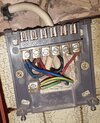Intending to replace elderly in-laws boiler Horstmann C17 timer with a Hive wireless thermostat but confused by the existing wiring.
The boiler is a Biasi Riva OV but has a strange setup in that it has no external thermostat and a manual heating/hot water diverter valve (Servowarm valve).
Due to memory problems she is struggling with the existing controller so the intention was to replace with a Hive so that we can remotely ensure the house is at a comfortable temperature.
The odd bit in the C17 is an apparent live link to terminal 4 (red wire photo attached). In the photo the lead entering on the left is from the fused switch and the lead on the right goes to the boiler, you can see that they cross over in the mounting plate.
The Biasi instructions state that any external equipment should be volt free.
The thing is this setup is currently working quite happily and has been for 15 years+
Can anyone offer any thoughts as to what is going on with this set-up?
The boiler is a Biasi Riva OV but has a strange setup in that it has no external thermostat and a manual heating/hot water diverter valve (Servowarm valve).
Due to memory problems she is struggling with the existing controller so the intention was to replace with a Hive so that we can remotely ensure the house is at a comfortable temperature.
The odd bit in the C17 is an apparent live link to terminal 4 (red wire photo attached). In the photo the lead entering on the left is from the fused switch and the lead on the right goes to the boiler, you can see that they cross over in the mounting plate.
The Biasi instructions state that any external equipment should be volt free.
The thing is this setup is currently working quite happily and has been for 15 years+
Can anyone offer any thoughts as to what is going on with this set-up?


